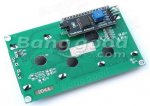Hi Haroen,
I'm almost tempted to say have you got good decoupling on that little thing.
That will teach me I changed from a oled1602 to lcd204 for checking...
the driver will work for both but
post#33 should have worked but when programmed display would appear scrambled until powered off and on again.
the idea being to show what happens and try avoid using the serout pin to send too a display.
I think the SENDING example was a bad example and may have appeared scrambled it worked on the lcd ,
it was meant to show we could send 80 characters at once and how it wraps around the display line 1 then 3 then 2 then 4
checking it on the oled1602 it wasn't quit right it appears you can have 64 characters for each line controller not 40 as I expected.
I'm assuming this would be messy on a oled2004.
I will change this to basic 4 line addressing and send 20 characters I'm sure I've used that before on a oled.
Sorry for the run around !
I'm almost tempted to say have you got good decoupling on that little thing.
That will teach me I changed from a oled1602 to lcd204 for checking...
the driver will work for both but
post#33 should have worked but when programmed display would appear scrambled until powered off and on again.
the idea being to show what happens and try avoid using the serout pin to send too a display.
I think the SENDING example was a bad example and may have appeared scrambled it worked on the lcd ,
it was meant to show we could send 80 characters at once and how it wraps around the display line 1 then 3 then 2 then 4
checking it on the oled1602 it wasn't quit right it appears you can have 64 characters for each line controller not 40 as I expected.
I'm assuming this would be messy on a oled2004.
I will change this to basic 4 line addressing and send 20 characters I'm sure I've used that before on a oled.
Sorry for the run around !



